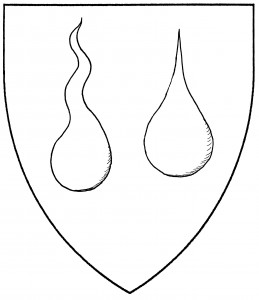A gout, or goutte, is a drop of fluid. The illustration shows a medieval depiction, with wavy sides, and a more modern depiction, which tends to be smooth and fat. The former is the preferred form. Other depictions, which show the gout fatter than it is tall, or comma-shaped, are not allowed.
A field or charge semy of gouts may be blazoned “goutty” or “goutté”. (The need for the distinguishing accent makes the French spelling inadvisable.) Originally, gouts were always found semy; examples both of goutty fields and of goutty charges date to 1282, such as the arms of Bulmer [ANA2 69]. It was only later in period that gouts began to be used as distinct, single charges, as in the canting arms of Drop, c.1460 [RH].
Post-period heraldry evolved special names for gouts of each tincture; these may be used in Society blazons, at the user’s discretion:
A “gout d’Or” (drop of gold) is Or. A “gout de sang” (drop of blood) is gules. A “gout d’eau” (drop of water) is argent. A “gout de larmes” (drop of tears) is azure. A “gout de poix” (drop of pitch) is sable. A “gout d’huile” (drop of olive oil) is vert. A “gout de vin” (drop of wine) is purpure.
The Chirurgeonate bears: Gules, on a goutte argent a fleam gules.
Gwendolyn Silvermist bears: Per pale wavy azure goutty d’eau and argent goutty de larmes.
Wilfried Rudiger Quellenmann bears: Barry wavy vert and argent, three gouttes de sang.
